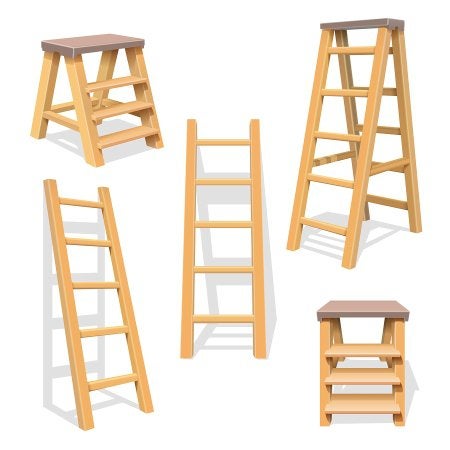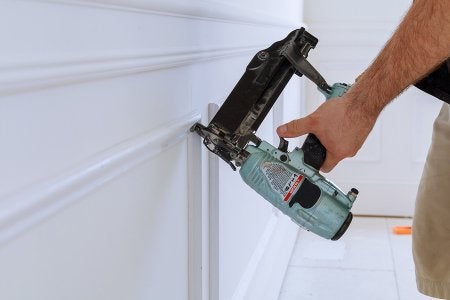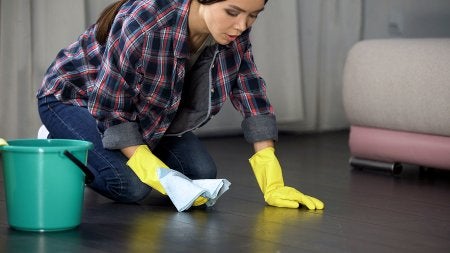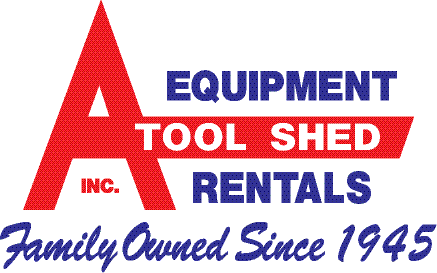-
Choosing the Right Size Ladder
Many homeowners make the mistake of using a ladder that’s too short for the job. This is because they often choose a ladder size that’s just a little longer than the height of the work area. Remember that the ladder will be at an angle, not straight up. Fortunately, if you’re opting for equipment rentals, you won’t end up making a pricey purchasing error, even if you initially pick a ladder that’s too short.

As a general rule of thumb, choose a ladder that is seven to 10 feet taller than the highest contact point for the ladder. The contact point might be the roof line or wall. When choosing a ladder rental, remember that the tallest point you can climb to is four rungs lower than the top. At the equipment rental store, you should check the ladder’s duty rating. This rating is the maximum amount of weight the ladder can safely support. Select a ladder with a duty rating sufficient to support both your weight and the weight of any rental tools and supplies you’ll be carrying up.
A Tool Shed offers high-quality equipment for rent in San Jose, including step and extension ladders. If you have any questions, you can reach us at (800) 286-6574.
-
Mixing Concrete by Hand
It isn’t difficult to mix concrete, especially if you rent the right tools for the job. Watch this featured video to see how one knowledgeable individual mixes concrete by hand for his projects around the house. He recommends that you wear gloves and a dust mask when working with concrete mix.
You’ll see him empty the bag of concrete into a wheelbarrow. He adds water periodically as he mixes the concrete with a garden hoe. Although this demonstrator is able to eyeball the amount of water he needs, it’s recommended that you measure the amount of water in accordance with the instructions on the concrete bag.
If you’re planning a project that involves mixing concrete , you’ll find all the equipment rentals you need in San Jose at A Tool Shed. Call us at (800) 286-6574, and ask us about our used tools for sale.
-
A Guide to Nail Gun Safety
Nail guns can make your household project much easier and quicker than using a manual hammer. However, it’s important to remember that this tool can also be risky if not used correctly. Tens of thousands of nail gun-related injuries are reported every year in the U.S. Take the time to educate yourself about the safe use of these tools, and you’ll be able to complete your project without any incidents.
Know your trigger.
Nail guns that feature bumps or automatic triggers, also known contact trip triggers, may result in unintentional and unsafe discharge of the tool. If they are available, you should instead choose a nail gun that features a single shot or full sequential trigger. Additionally, avoid keeping the trigger squeezed when you aren’t actively nailing.

Inspect the tools and lumber.
Lumber that features knots, nails, straps, or hangers can cause the fired nail to ricochet, which can result in a serious injury. Always check the lumber for potential problems before working on it. Additionally, double-check your tool for signs of damage, and avoid using a tool that may malfunction.
Wear personal protective equipment (PPE).
Safety gear isn’t a substitute for following safe usage guidelines for nail guns, but it can help lessen the effects of an accident. Always wear safety goggles or glasses rated for high-impact protection. Since nail guns can be noisy, you should also wear hearing protection. Wear work gloves too. These won’t stop a fired nail, but work gloves can prevent your grip from slipping.
Know when to use a hammer.
As convenient and powerful as nail guns are, they can’t be used for every single nailing job. There is an increased risk of injury when nail guns are used in awkward positions, as the recoil and the tool itself are more difficult to control. Nailing in close quarters, toe-nailing, and nailing above the height of your shoulders are examples of situations that call for an ordinary hammer.
A Tool Shed offers daily, weekly, and monthly tool rentals in San Jose, including everything you’ll need for your carpentry project. Ask us about our easy-to-use pneumatic nailer by top brand Porta-Nails! You can reach a friendly associate at (800) 286-6574.
-
Tips for Using a Floor Polisher
Floor polishers are ideal for restoring a beautiful, shiny appearance to a floor. Since most people don’t use floor polishers on a regular basis, these tools are typically rented instead. It can take a bit of practice to master the correct usage of this heavy, bulky equipment. Using the following tips will make it much easier for you to control the machine properly.
Clean the floor first.
Novices often assume that there’s no need to clean the floor before using a floor polisher. But actually, you should use a vacuum cleaner with strong suction to remove all debris and particles from the floor. Doing this before you turn on the floor polisher will make controlling this tool easier. Floor polishers aren’t able to remove debris from the floor, and so any particles left on it may cause scratches.

Get ready to use the polisher.
You should have a spray bottle with floor polish close at hand. If you have a work belt, you can attach it to that. Wear rugged work gloves for better handling of the equipment. Protect your feet by wearing closed-toed, sturdy shoes or work boots. Check the pad of the floor polisher. It should be clean, and there should be no bits missing. Adjust the handle to the proper height.
Start in the farthest corner.
You should start the machine at the farthest point away from the exit. Double-check that the power cord will reach all the way across the room, and then plug in the floor polisher. Apply floor polish directly to the pad or to the floor, depending on the instructions for the model you’re using.
Overlap your rows.
Turn the floor polisher on and guide it in a row across the room. Each time you start a new row, overlap the previous row by about one-third to ensure even coverage. Avoid walking on the areas you’ve already polished.
You can rent top-of-the-line floor polishers at A Tool Shed . We also offer used tools for sale in San Jose. To inquire about our current inventory, give us a call at (800) 286-6574.
